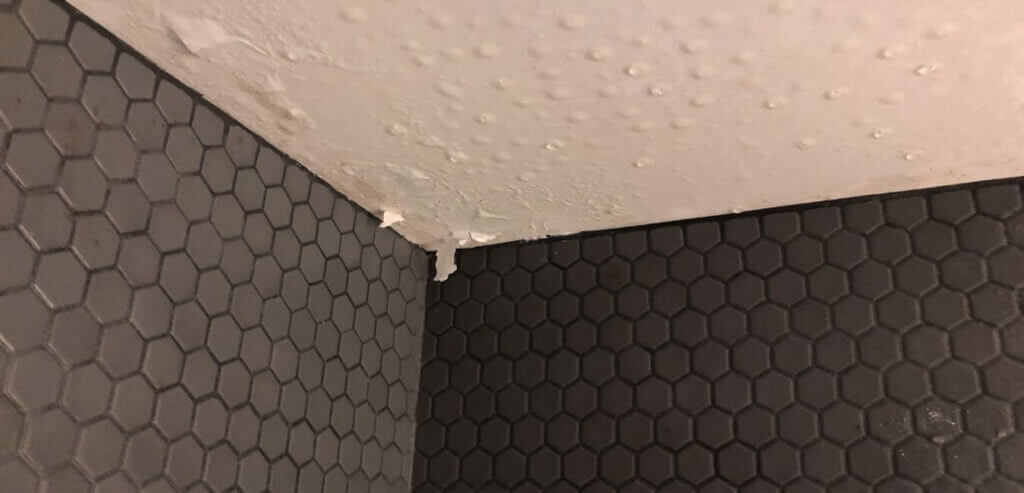Knowing how to find the source of water damage is often a result of putting the puzzle pieces together and a process of elimination. The key is catching small leaks before they become big problems.
Where to Check for Water Leaks
Some quick checks around the house can help you identify if you have a leak. There are some typical places that you can look for leaks.
Water Meter
If your meter moves when you shut off the water, you have a leak.
Follow these three steps to turn off the water and check the meter:
- Step 1: Locate Your Water Meter. If you don’t know where your meter is, call the water department to find its location.
- Step 2: Turn Off the Water. Turn off all the water in your home, including the dishwasher, faucets, washing machine, and irrigation system.
- Step 3: View the Meter. Meters vary slightly, but in general, there should be a low flow indicator (looks like a star or triangle), sweep hand (long red hand), and odometer (moving numbers). Watch the low flow indicator. If it’s moving, you have a leak.
Your water meter may not pick up small leaks. If you still think you have a leak, but the indicator and sweep hand aren’t moving, write down the odometer meter number and come back in about 30 minutes to re-record the reading. If there is a difference in the two numbers, you have a small leak.
Water Bill
Review your water bills for the past few months. In general, your water usage should stay consistent month to month. If you have a swimming pool or irrigation system, you may notice seasonal changes in your usage. Otherwise, if you see significant increases in your bill, you have a leak.
Toilet
One way to find the source of the leak is by doing a food coloring test. Add a few drops of food dye to your toilet tank and wait. If the color shows up in the toilet bowl, then you have a leak allowing water to flow from the tank to your drain.
Yard
Check your yard. Not all leaks are inside. Wet spots in your lawn, sinkholes, sewage smells, cracked pavement, and spots on the lawn that are unusually green compared to the rest of your yard are all signs of exterior water leaks.
Types of Water Associated with Damage
Knowing how to find the source of water damage is important because it can impact the amount of work needed and the cost of repairs. It also helps determine the category of the water associated with the damage.
There are three types of water associated with water damage.
Category 1: Sanitary Liquids
Water is clean and from a sanitary source such as a sink, showerhead, or drinking water. It does not contain toxins and poses no threat to humans. Damage is easy to dry and fix if caught early. But, if not addressed it can lead to Category 2 water damage.
Category 2: Grey Water
Grey water is contaminated and contains microorganisms. If the source of water damage is from your dishwasher, aquarium, sump pump, washing machine, sink drain, or overflowing toilet, it is “grey.” This water may cause illness if ingested.
Category 3: Black Water
Black water is unsanitary liquid that contains bacteria and other organisms. It is the most severe damage to your home. Polluted water includes sewage backup, water containing feces, and contaminated standing water. It can cause severe illness or death if ingested.
Classes of Water Damage
Classes of water refer to the amount of water and how contaminated it is with pathogens and toxins. Classes categorize the amount of damage done to your home or structure.
There are four classes of water damage:
- Class 1. Causes the least amount of damage. Clean up is limited to part of the room or area. Minimal effort is required to dry the space.
- Class 2. Water impacts a large space. Materials such as carpet, cushions, furniture, and flooring may be damaged and are at risk of growing mold. In addition, water seepage up walls is less than 24 inches, and repairs are more involved.
- Class 3: Water damage to the entire property. Usually caused by a broken sprinkler, burst pipe, or collapsed ceiling. Water saturates insulation, walls, carpet, and subfloor in the whole area. If not immediately addressed, it can result in safety and health problems.
- Class 4: Often a result of a severe flood. Water damage affects the structural integrity of the building. This type of leak requires water restoration and removal procedures.

What Should You Do After You Find Water Damage?
If you experience flooding or water damage, the most important thing is to stay safe and protect yourself. Never put yourself in a situation that could cause you harm.
To respond to a leak:
- Turn Off the Power. Shut down the electricity by switching off the circuit breakers and unplugging devices. If turning off the power requires you to stand in water, wait for an electrician.
- Wear Protective Gear. Wear rubber gloves, waterproof boots, and protective clothing to avoid exposure to bacteria in the water.
- Protect Your Valuables. Remove valuables such as documents or electronics. If you can, remove wood furniture, rugs, or other fabric items.
- Call Your Insurance Company. Get started on filing an insurance claim. The insurance company will send a claims adjuster to document the damage and estimate repairs. Take pictures of the damage and keep detailed records.
ServiceMaster Restoration by RSI Can Help
Fixing water leaks lowers your bills, helps preserve water, and can save you from more extensive damage.
Call on ServiceMaster Restoration by RSI. We’re available 24 hours a day, seven days a week, 365 days a year at (405) 251-7286 . We know how to find the source of water damage and can help you today.

